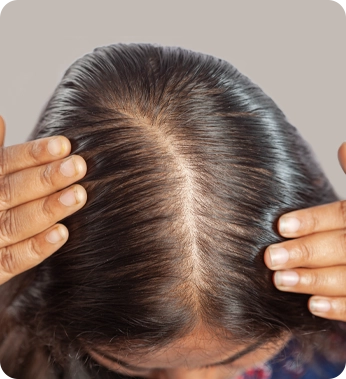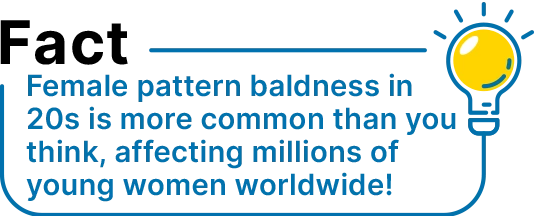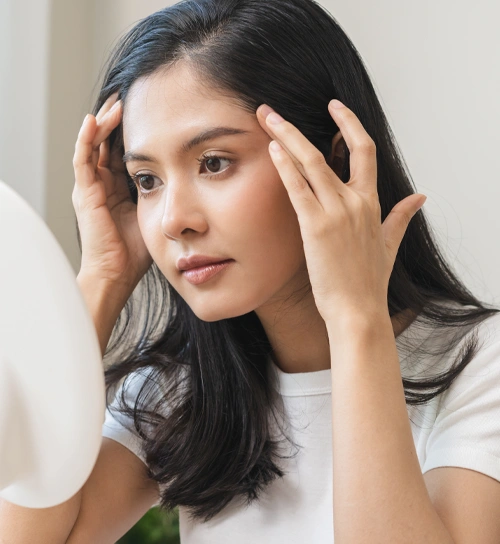Personalised Homeopathic Treatment for Female Pattern Baldness
Compassionate Care for Your Hair Health
Book your Appointment
Experiencing a widening hair partition, increased hair shedding, or thinning at the crown? You're not alone. Female pattern baldness can begin as early as the 20s, with prevalence increasing with age.
Unlike men, women typically experience diffuse thinning without a receding hairline, which can be particularly distressing.
At Dr Batra's®, we provide personalised homeopathic treatments that address the underlying causes of hair loss, strengthen hair follicles, and promote natural regrowth. Our safe, side-effect-free approach restores hair health without invasive procedures or harsh chemicals
Personalised Hair & Scalp Analysis
Comprehensive assessment to determine your unique hair loss pattern and scalp condition
Root-Cause Treatment with Homeopathy
Treat the root cause, which balances hormones, strengthens follicles, and nourishes the scalp for sustainable results
Safe & Natural
No adverse side effects, making it suitable for women suffering hair loss due to various causes
Trusted by Over 15 Lakhs+ Patients
Demonstrated 90% success rate in hair regrowth treatments
AI-Based Monitoring & Regular Check-Ups
Track your progress with advanced tools and personalised care
Step 1
Reduces Hair Fall - Strengthens follicles to minimise shedding
Step 2
Stimulates Regrowth – Reactivates dormant follicles
Step 3
Enhances Hair Density – Improves thickness and fullness
Step 4
Stabilises Hair Loss – Prevents further thinning
Step 5
Maintains Healthy Hair – Supports long-term hair health

| Approach | Homeopathy | Conventional |
|---|---|---|
| Holistic | ||
| Addresses Root Causes | ||
| Safe & Natural with Minimal Side Effects | ||
| Personalised Treatment | ||
| Supports Lifelong Follicle Health |
According to the Ludwig scale, female pattern baldness typically progresses through the following stages:

Common signs of female pattern baldness include:
Several factors can contribute to female pattern baldness:
Genetics
A family history of hair loss increases the risk
Hormonal Changes
Menopause and other hormonal shifts can trigger hair thinning
Medical Conditions
Thyroid, PCOD disorders and other illnesses may contribute
Medications
Certain drugs can cause hair loss as a side effect
Stress
Emotional or physical stress can exacerbate hair loss
Yes! Early homeopathic treatment can slow or halt hair loss by strengthening hair follicles, balancing hormones, and improving scalp health. If the follicles are still active, regrowth is possible. The sooner treatment begins, the higher the chances of denser, healthier hair regrowth
Yes, homeopathy targets the root cause by balancing hormones, improving follicle strength, and boosting scalp circulation. By reducing stress-related triggers and nutritional deficiencies, homeopathy can effectively slow down hair thinning and prevent further progression, making it a long-term solution for female pattern baldness.
Yes, stress-induced hair loss (telogen effluvium) can resemble female pattern baldness, but it is usually temporary and occurs due to emotional stress, illness, or sudden weight loss. Unlike female pattern baldness, telogen effluvium affects the entire scalp, and hair regrows once the trigger is resolved.
Generally, female pattern baldness does not affect eyebrows, but hormonal imbalances and thyroid disorders can contribute to eyebrow thinning. Conditions like alopecia areata or iron deficiency may also lead to hair loss in eyebrows, eyelashes, and other body areas.
If follicles have completely miniaturised or closed, regrowth is unlikely. However, homeopathy can still help maintain existing hair, slow down further loss, and improve scalp health. Starting treatment before excessive thinning occurs increases the likelihood of preserving and thickening hair strands.
Female pattern baldness appears as gradual thinning at the crown and widening of the partition, rather than patchy bald spots. Hair strands become finer over time, and scalp visibility increases. Unlike male baldness, women rarely experience complete baldness but may suffer significant volume loss.
The most commonly used homeopathic medicines for female pattern baldness include Silicea (for brittle hair and weak roots), Phosphorus (for excessive hair fall with dandruff), and Natrum Muriaticum (for stress-induced hair loss). A personalised homeopathic plan ensures the best remedy based on symptoms.
Achieving thicker, healthier hair requires balancing hormones, improving scalp circulation, correcting nutrient deficiencies (iron, biotin, vitamin D), and reducing stress. Homeopathy, along with dietary changes and gentle scalp care, supports hair thickness and prevents further hair thinning.
No, there is no single pill that permanently cures baldness, but homeopathy offers a long-term, natural approach to controlling hair thinning. It strengthens follicles, prevents further loss, and promotes regrowth without side effects, making it a safer alternative to conventional treatments.
Yes, but only if the hair follicles are still active. Homeopathy stimulates dormant follicles, strengthens roots, and promotes regrowth by improving scalp health and reducing internal triggers.